
|
 |

|
 |
Dancing figures from the temple cars of South India Text and photos: Dr. Susil Pani, Pondicherry November 11, 2008 It is known that all the classical Indian dance forms have evolved from Natyashastra, the treatise supposed to have been written by sage Bharata. There are lot of evidences in the form of postures and inscriptions in temples all over the Indian subcontinent. The present study deals with the dancing figures seen in the temple cars of South India. The present day temple cars are made from wood which decays over a period of time. The temple cars are a big source of images telling stories from Ramayana, Mahabharata, Puranas, Vedas, Upanishads, and other scriptures. There are presently more than nine hundred temple cars in Tamilnadu and Pondicherry. As it is not possible to cover all of them, only a representative sample is taken for the study to include cars from Pondicherry, Thiruvannamalai, Chidambaram, Kumbakonam, Nagapattinam, Avinashi, and Milam. The present study has been broadly classified into dancing figures relating to Shiva, Vishnu, Shakthi and others.  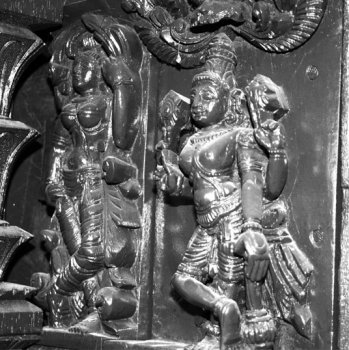 Shiva Nataraja: The Cosmic Dancer Shiva as Nataraja is the cosmic dancer. He is the master and source of all the dance forms. He is also the source of all art forms - dance, music, drama, etc… Shiva as Nataraja taught all the art forms to Bharata muni, the rishi from Bharat Desh (the land of Bharata). Bharata muni is considered to be a rishi of the Vedic era. Some consider that Bharata muni refers to a number of rishis of the Vedic time. It is said that Lord Shiva instructed Bharata muni to write the Natyashastra. It is considered as the fifth Veda after the Rig Veda, Sama Veda, Atharva Veda and Yajur Veda. Natyashastra literary means natya and shastra. Natya includes all art forms including dance, drama, music etc, shastra means the knowledge or codification and rules and regulations to be followed for the performance of Natya. Most of the Shiva temples in south India have a separate shrine for Nataraja inside their temple premises. A separate hall called Nata mandapam is present next to the Nataraja shrine for the dance presentations. The temple of Chidambaram has Lord Nataraja as the main deity instead of the usual Shiva lingam. Shiva is considered to have started all the one hundred and eight tandavas. These are presented as one hundred and eight Karanas. These are present in some of the temples including the Brihadeeswara temple of Tanjore and the gopurams of the Nataraja temple of Chidambaram. In the temple cars, the most common and most popular presentations are the Ananda Tandava, Rudra Tandava, Urdhava Tandava and Chatura Tandava. Ananda tandava is the Dance of Bliss by Nataraja and forms the most common Tandava. Shiva in this form is four handed. The right hand in front is in Abhaya mudra while the backhand holds the damaru. The left hand in front usually is in Gajahasta and the back hand holds the Agni. The left leg is raised in kunchita pose and the right leg is firmly placed on the demon Apasmara. Shiva has a quiet, smiling but serene face. Behind Shiva, one may see many flying Vidyadharas. In some panels, one can see Goddess Parvati as Shivagamasundari next to Lord Shiva. In the Dance of Bliss, Shiva is self contained. He is the source of all creation, vibration and movement. The damaru represents this source. The right hand in Abhaya mudra, presents blessings by the Lord, hence the protection provided by him for the sustenance and maintenance of life. The back hand holding Agni or fire destroys the old so that the new can be created. The right leg is firmly placed on Apasmara - which shows the lord having full control over the ego and all the sense organs. The raised leg is the final path for salvation or moksha. The Lord delivers his devotees from the illusion or maya of the outer senses and ego to realize the truth and unite with the ‘Divine.' 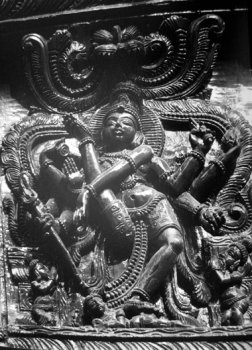 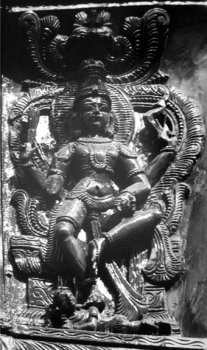 The Urdhava tandava Shiva as Urdhava Tandavamurti is very popular in the temple cars. It is usually presented in a panel of images to include other gods and goddess. The story behind the panel presentation is that long time ago, there was a great debate among the devotees of Lord Shiva and Parvati as to who was a greater dancer. Hence to resolve the issue a great competition was held between Lord Shiva and Goddess Parvati. Other gods are seen to accompany this great event. Nandi is seen playing the mridangam, Vishnu playing the cymbals, Saraswathi playing the veena, Ganapati playing the tanpura and Brahma either playing a stringed instrument or sitting as a judge. In the same panel, Parvati is seen in her Kali form, in a fierce dancing posture. It is said that she could excel Lord Shiva in all the tandavas. In the end, Shiva does Urdhava tandava. Urdha literally means raised up; in this tandava, Shiva is seen to raise his right leg vertically up with the foot of the leg facing the sky. This image of Shiva is called Urdha Tandavamurti. He plays the damaru with two hands in front. In some panels, the left leg is shown raised up; in one rare panel there are two images of Lord Shiva one with right leg raised and another with left leg raised placed side by side. Lord Shiva is seen with four arms but sometimes with eight arms. Two hands play the damaru and other two hands are in Suchi mudra. Kali is seen with eight or ten hands holding many arms in the same panel in a dancing posture. In some she is seen accepting her Lord's supremacy as she is not willing to raise her legs in the presence of men. In some she is seen below the image of Lord Shiva with folded hands; sometimes she is seen angry and dismayed and feels that Lord Shiva has tricked her as he is aware that she would not attempt such a movement in front of men. It is also an indication that women in general should not attempt such extreme movement during dance presentation while men are allowed to do so. In fact this type of tandava forms a main dance item for the Mayurbhanj Chhau, Manipuri dance and some of the traditional martial art dances from Kerala and Tamilnadu. 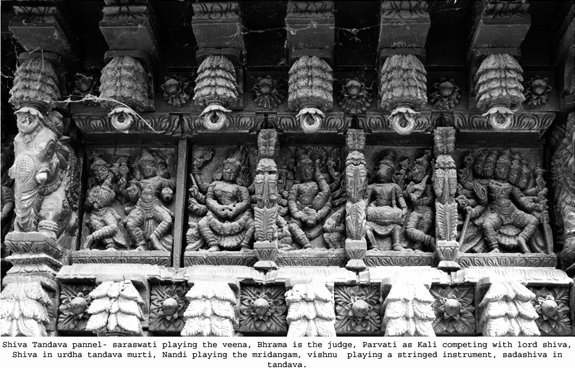 Urdha tandava panel Brahma, Vishnu, Nandi and others in Urdha tandava panel Nandi is the vahana of Shiva - Parvati as seen in the Urdha tandava panel playing the mridangam - a drum. He is seen in zoomorphic form of having a human body with a bull's face, one hand ready to strike the mridangam. He is also called as Nandikeswara - Nandi with the power of Eswara (Lord Shiva). Nandikeswara is also the name of the third century Indian author of the treatise Abhinayadarpana which deals in great detail, the shastra of abhinaya. Even till date, this is faithfully followed by all the classical Indian dancers for performing abhinaya. Lord Brahma is seen sometimes with three faces (the front one hidden) either playing some musical instrument or seated on a lotus as a judge. Most of them have Goddess Saraswathi seated next to him, seated on a lotus playing the veena. Lord Vishnu is seen to be playing the cymbal or flute and supposed to maintain the tala of the dance duel. Ganapati is seen sometimes playing some musical instrument in the same panel. 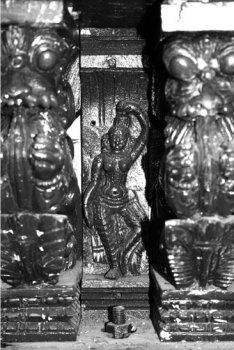 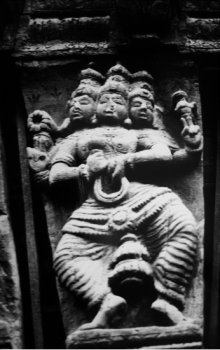 Ardhanariswara It is said that the genesis of Ardhanariswara form of Lord Shiva and Parvati is the form of the Urdha tandavamurthi. At the end of the duel, Shiva and Parvati merge together to form Ardhanariswara. In this form, the right half is that of Shiva and the left half is that of Parvati. It declares that both are not separate but One. Shiva and Parvati do not exist separately but as one consciousness. Shiva is the purusha and Parvati is prakriti. While Shiva is the source, Parvati as Shakthi is the force for all action. Hence both Shiva and Parvati need to be present for all action, movement, vibration etc. 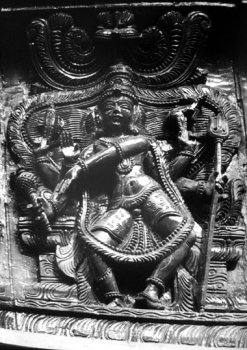  Chatura Tandava There is an exclusive panel of Shiva tandava in the temple car of Villianur Shiva temple at Puducherry. In this panel, Shiva is showing not only his Ananda tandava and Urdha tandava but also his Chatura tandava. Shiva is seen as Sadashiva with five heads and ten arms in a classic chouka posture in Chatura Tandavamurthi. He is seen as eight handed Shiva in Urdha Tandavamurthi in the centre of the panel and four handed Ananda Tandavamurthi. Nandi is seen to play the mridangam, Saraswathi the veena, and Vishnu the gini (tiny cymbals). Shiva in other dance forms Gajasura Samhara Murti In this image, Lord Shiva is seen to dance on the head of the elephant headed demon called Gajasura. He is supposed to have cut open the body of the elephant demon and danced on his head. He is with eight arms with four arms holding open the elephant's stomach, one hand holding the damaru, another holding agni and his torso in extreme tribhanga with one leg bent up at the hip and bent at the knee and the other leg firmly placed on the head of the asura. Goddess Parvati is seen on the side holding a child. 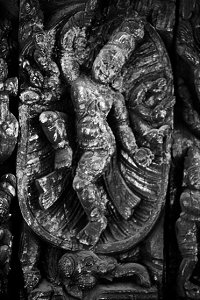 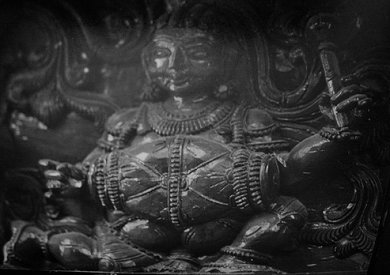 Shiva ganas The Shiva ganas and bhoota ganas are the devotees of Lord Shiva and hence are depicted in dance posture in the temple cars. In one image, a beautiful Shiva gana is seen seated with a mridangam on his lap, the right hand striking the drum and the left hand with a stick about to strike the other side. Some of the Shiva ganas are seen to play the drum, blow the trumpet, or play a stringed instrument. They are sometimes four handed. Rare forms of Shiva In a rare panel presentation Lord Shiva is shown in six different dancing postures. In the first figure he is wearing the decorated mukuta and blowing a trumpet. The snake is around his neck. He is wearing a diamond necklace; the left hand is in posture, on his left is seated a Shiva gana with a knife and mace. Shiva is seated and the legs are bent, a lion cub at his right foot and a lady on the left foot. The second figure shows the Lord with a sword and a shield in standing posture. He wears a mukuta decked with ornaments and appears to do a war dance, with the snake draped around him. In the third figure, Lord Shiva is four handed, on a mythological animal (similar to makara) holding the snake and shield in the left hand and sword and animal's mouth in the right hand. He is seen to squat firmly on the yali. In the fourth figure, he is seen with a serene face, the snake around the neck, and two flying Vidyadharas on his two back hands, the two front hands relaxed on the sides. The Lord is seen resting on the right toes and left knee. The fifth posture of Lord Shiva is similar to the Narasimha avatar of Lord Vishnu. He has a lion's face with the sword and shield in the back hands and a knife in the right front hand and the left hand holding the snake. In the last figure on the panel, Lord Shiva appears to do a dance with the mace in two hands. He is decorated with a mukuta, necklaces and decoration of beaded bridle around the waist and the upper thighs and a dagger firmly placed on the right thigh, the snake around the neck. The entire panel of the six images of the Lord was done by the artist depicting many aspects of the Lord. Nritta Ganapati 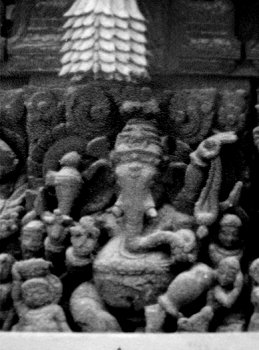 Being the son of Lord Shiva and Parvati, Lord Ganesha is a master of dance. He is presented as dancing Ganesha and called as Nritta Ganapati or Nadana Ganesha or Aadum Pillayar in Tamil. In this form, he may have eight hands bearing the elephant goad, cakes, noose, an axe, tusk, a quoit called valaya and a ring. One hand in dancing pose, the legs are bent in Kunchita pose. Most of these figures are solitary and independent. In some rare forms, he is presented as ‘Pancha Mukha Nadana Ganapati.' Here he has five faces and at the same time, is in dancing posture. Rarely is he present in the Urdha Tandava panel playing some musical instrument. In many of the dance presentations, Lord Ganesha is invoked by the Ganesha Vandana, some specific tandavas are performed called Ganesha Tandava. Dance poses of Vishnu Balamurali Krishna: Lord Vishnu is seen in many dancing poses in this Krishna avatar. He is seen as Balamurali Krishna, playing the flute and enchanting the cows, gopis and the cowherd boys. Hence he is seen in beautiful tribhanga posture, standing and playing the murali (flute) while the calf, cows and others are surrounding him. As Muralidara, Lord Krishna is seen to play the murali under the Kadamba tree, drawing the gopis to him by his melodious music from his flute. In some panels, Krishna is seen along with Radha, both in dancing posture, while Krishna plays the flute. 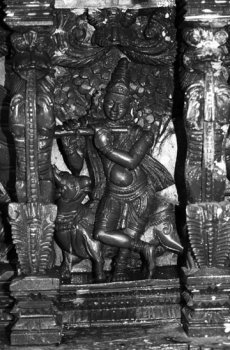 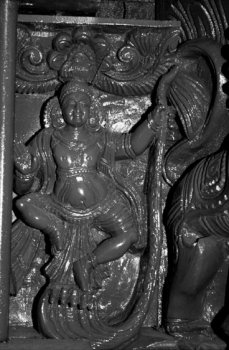 Kaliadamana Lord Krishna is said to have jumped into the depths of river Yamuna to teach a lesson to Kalia, the great arrogant serpent king. He is seen to dance on the hood of the serpent Kalia, while holding the tail in the left hand. The right leg is firmly placed on the head of the serpent. The left leg is slightly bent, the body in classic tribhanga posture, the right hand in Abhaya hasta, blessing all those who seek his protection. Two Nagakanyas with folded hands are seen on his side, praying to the lord to spare the life of Kalia. Krishna destroys all the dark forces of ego represented by the black serpent Kalia and on surrender to him, he delivers and shows the path to the ‘Divine.' Devotees dancing In many of these temple cars, the devotees are shown dancing, like a dancing sadhu with a beard holding a chouli in each hand .The chouli bearer and dwarapalas are also shown in classic tribhanga postures. 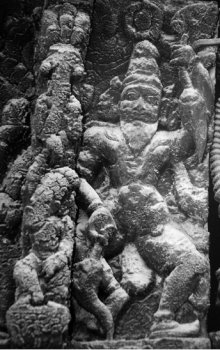 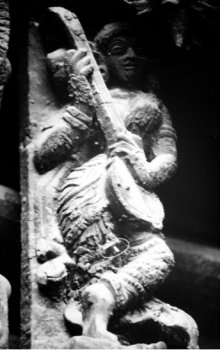 Lute players Almost all temple cars have figures of lute players. They are usually ladies standing in tribhanga with one leg across the other, holding a stringed instrument and playing it with both the hands. It could be a tanpura or veena.  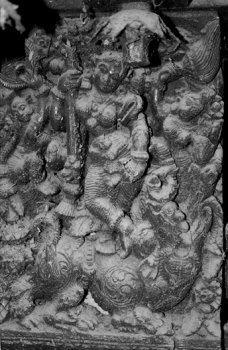 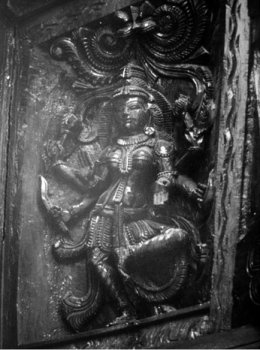 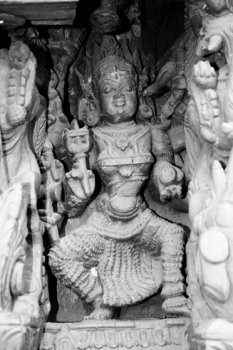 Saraswathi, Ganga and Parvati Saraswathi is usually seen to be seated either on a raised platform or on a lotus. She is seen to play the tanpura or the veena. She is sometimes presented along with Brahma in the Urdhava tandava panel, otherwise independently. Her back hand may hold a lotus or in Abhaya hasta and a scroll. Ganga Devi is usually presented to be riding the mythological yali like figure called Makara. She is in tribhanga and playing the veena. She is usually decorated with necklaces around her waist and neck. Sometimes she is presented as descending, dancing finely on the locks of hair of Lord Shiva in his Gangadharamurthi avatar. In this independent panel, a Devi (mostly goddess Parvati) is seen in classic chouka posture with the hands joined together about to rise together. I have not included panels of ‘Dasavatar' which is a very popular item of Odissi dance. Invariably the temple cars of Vishnu have a panel devoted to the ten incarnations of Lord Vishnu - the Dasavatar panel. The stories from Ramayana, Mahabharata, Puranas etc., are presented as dance items in all the Indian classical dances like Ashtanayaki, Sita Swayamvaram, Rama killing Ravana, Suryastaka, Asthasambhu to name only a few. These are also presented in the panels of the temple cars but will be out of scope of this short presentation. Dr. Susil Pani is an eye doctor from the state of Orissa, now settled in the city of Puducherry. He comes from a very illustrious family, his father being late Dr. Raghunath Pani who was an educationist, writer, dramatist, composer, and musician - both Carnatic Veena and Hindustani vocal singer. Dr. Susil Pani has been interested in photography from his college days and has been taking pictures on a variety of subjects. His interests include: Indian classical dance forms, temple cars, temples, stage photography, nature, etc. He has already presented the following in solo photo exhibits: Indian classical and folk dances, spiritual significance of flowers, chariots of god: temple cars, general photography. He can be contacted at raghuclinic@yahoo.com Acknowledgement references: Stapati Guru Sri Rajamani and Mr. Bhuvansundaram: The Rathakaras Prof. Vijay Venugopal: French Institute of Pondicherry Prof. Raju Kali Doss: Temple cars of Tamilam Sangeeta Dash: Director Meera Dance Academy |